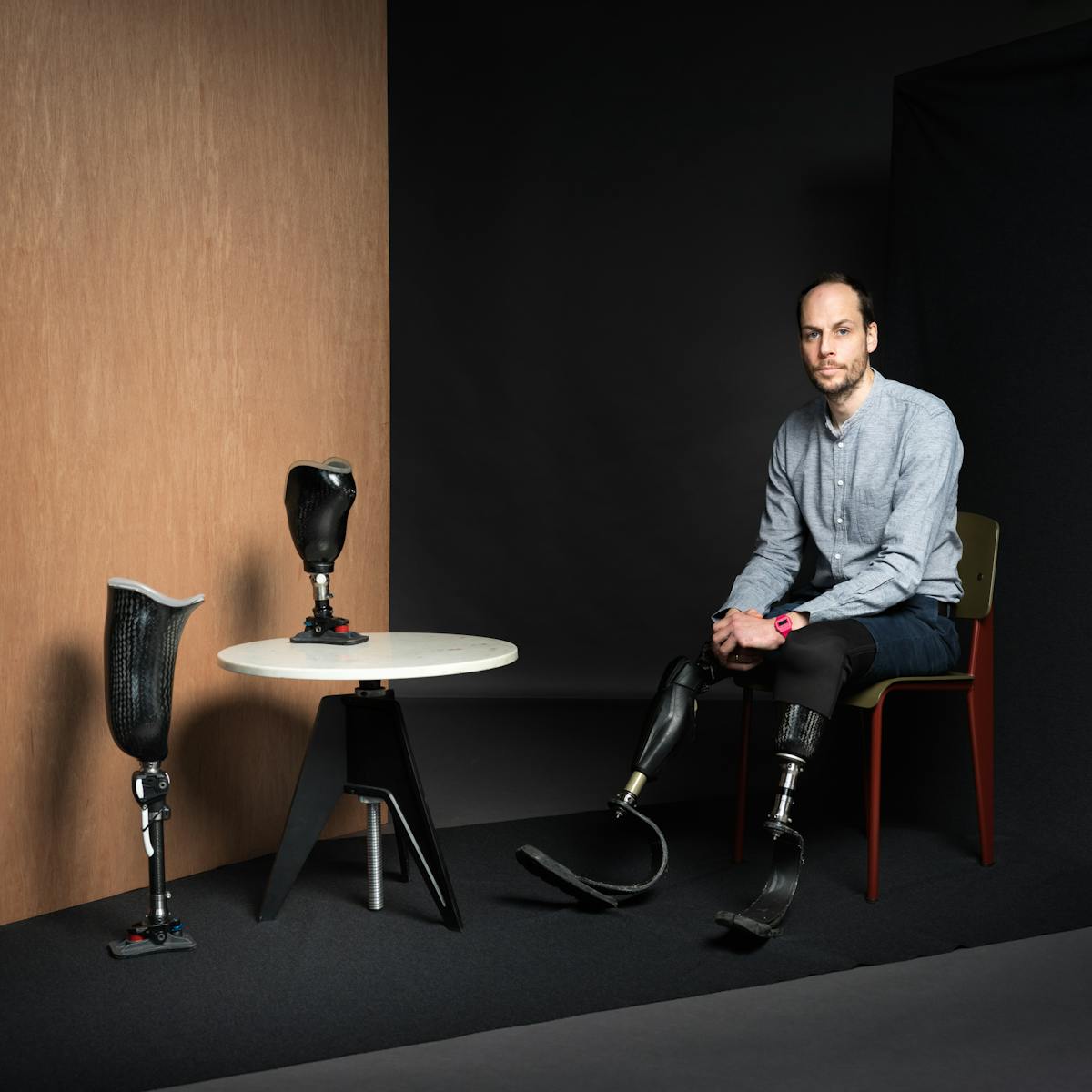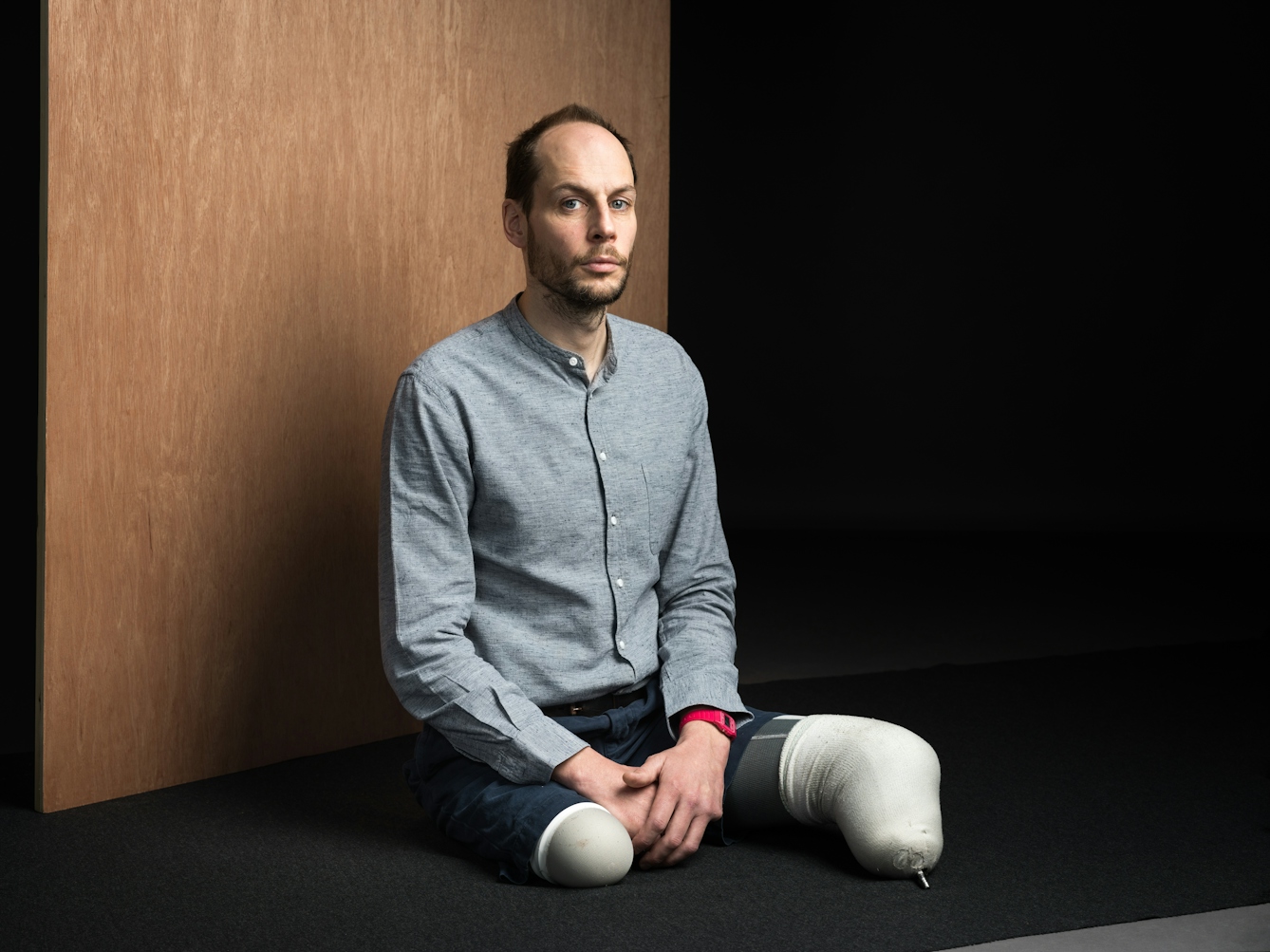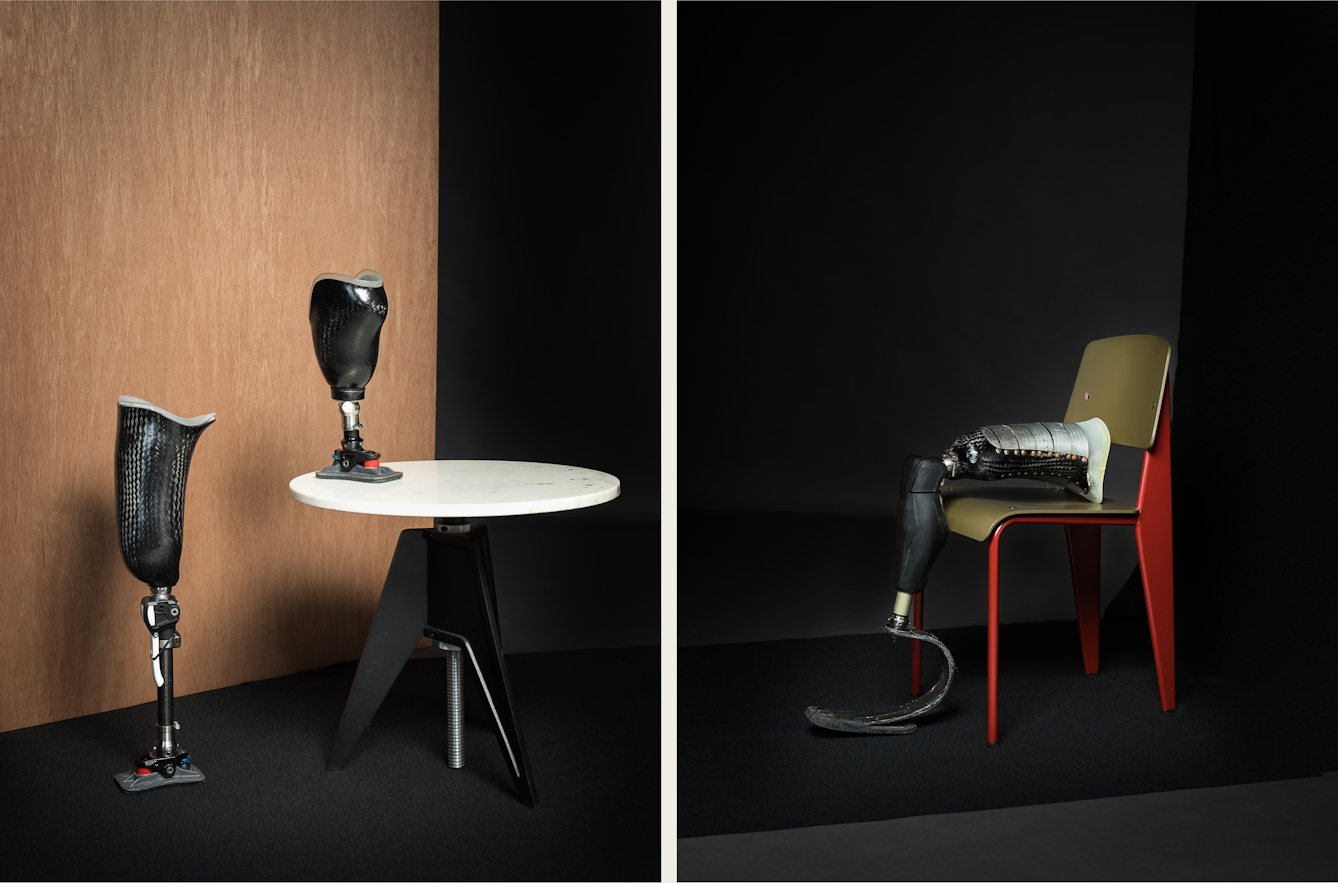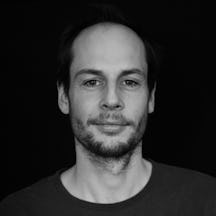Harry Parker’s life changed overnight when he stepped on a bomb in Afghanistan and lost his legs. In this extract from ‘Hybrid Humans’, Harry revisits the shock and pain of the loss, and explains how his life has changed. He argues that being an amputee in the 21st century doesn’t make him an outlier; we are all hybrid. And the possibilities to merge human and machine are greater than ever before.
A dispatch from the frontiers of man and machine
Words by Harry Parkerphotography by Steven Pocockaverage reading time 8 minutes
- Book extract

I open my eyes to the ward. The soundtrack is back: the low hum of machines, the shuffle of a nurse, a monitor chiming on the other side of the ICU. I inch my head around. Curtains are drawn around the bay and the lights are dimmed. The middle of the night.
I lie and stare at the wall and become aware of my body. A roll call of body parts checking in. It’s too painful and strange to be me – I am dislocated from this broken flesh. My nerves have been shocked by explosives, and everything below the neck is fizzing. There is a whirring also: the analgesia dulling the pain, retuning its frequency so it is just white noise.
I feel for my legs along the map of synapses I’ve known a lifetime, but now my legs are distant, shimmering in a kind of hot furnace beyond my leaden arms and aching back, and through the sharpness of lesions and bruising, and the fizzing white noise blossoms into pain.
I recoil from it and press the PCA (patient-controlled analgesia) button; it drones and pushes morphine into my central line and after a while I am unconscious.
The journey into a second life
During those first weeks, the shock and drugs and countless surgeries distorted everything. Dreams crossed into waking, so nothing felt real.
My imagination seemed to be protecting me from what had happened, walking me around the ward so I could look back at the bed and my body in it, or transporting me to places I knew from childhood: to dreams of home, of schools, of the town centre where I was first given the freedom to go shopping on my own – walks from my youth that felt more real than the medicalised world I’d woken to.

“If I was offered the chance to rewind, to never have stepped on a bomb, not only would I refuse, I’d actually be terrified of losing this new part of my life.”
It was as if my imagination had kicked into overdrive, emerging to take the reins and guide me through the trauma and strangeness – to help me accept a body I knew was mine, but which was full of pain and attached to the wall of a hospital by pipes and wires. And broken. The left leg gone below the knee, the right halfway down the thigh.
I’ve fumbled around for the memory: that moment I gasped wide-eyed with the realisation that I had lost my legs. I can’t find it. No appalling shock of a doctor or family member breaking the news to me. Instead there are many wakings – from deep, comfortable sleep, from anaesthetic oblivion, from dreams horrible and brilliantly surreal – each one eroding a little more of my old self, making way for the new one that was forming.
Each year, as 18 July approaches, I think again of how my life has changed. I’ve heard American military veterans call it a ‘re-birthday’ and celebrate their second lives.
Each year, as 18 July approaches, I think again of how my life has changed. I’ve heard American military veterans call it a ‘re-birthday’ and celebrate their second lives. I did mark the day in the first year. I had a load of friends round to my flat and had a barbecue. Just a party, no speech or cake, and most people didn’t let on that they knew the significance of the date.
As the years have passed, I’ve done less: a night in the pub or a raised glass over dinner. And last year I received a text at lunchtime from a friend telling me to have a good one and it took me a few seconds to realise what he was talking about.
The moments of stepping on an improvised explosive device (IED) are seared into my memory – they seem as perfectly formed as the day it happened: unforgettable, yet probably as unreliable as any of my memories, altered and embellished with each re-remembering. I don’t think about it much any more. It’s been ten years, and too many experiences are stacked between that day and now.

“It is 18 July again. I am reminded this year by the date on the appointment letter from the limb-fitting centre: my microprocessor knee needs a service.”
My dreams are different. In sleep, I don’t see myself with or without legs, I simply see me. And the daydreams of that broken body lying in hospital have changed too: it is neither what I hoped for, nor what I feared – it is normal. A loss grieved for and accepted. I am not a victim, unable to walk, nor am I entirely freed from my disability.
And while some horizons have contracted, others have expanded. Now, if I was offered the chance to rewind, to never have stepped on a bomb, not only would I refuse, I’d actually be terrified of losing this new part of my life. It would be to change my identity, to erase all those experiences, both good and bad, that make me who I am.
A slice of ordinary life
It is 18 July again. I am reminded this year by the date on the appointment letter from the limb-fitting centre (my microprocessor knee needs a service). I’m late. It’s been a hard night. Our two children have taken turns being awake – another cold – and now my daughter is refusing to get dressed.
I pull on my legs while discussing with my partner who will do the nursery pick-up. It is automatic: roll the liners over my stumps and click into the sockets, no novelty, no flinching – a muscle memory strengthened over ten years.
Then I put in my contact lenses. The first goes in routinely, but my eye flinches around the second lens, flattening it against my finger. I try prodding it in again. It falls on the floor.
In my early 30s I started wearing glasses. I hated the way they felt and the barrier they threw in front of the world, so I tried contacts. “Only a few hours each day to begin with,” the optician had said. “Let your eyes get used to them. Let your tolerance build up. And take them out in the evenings, so your eyes can rest.”
“Like learning to use prosthetic legs,” I replied, but he didn’t understand.

“I pull on my legs while discussing with my partner who will do the nursery pick-up. It is automatic… no novelty, no flinching – a muscle memory strengthened over ten years.”
My half-dressed daughter is banging the shower door open and closed. It’s a spaceship and she’s going to the Moon. She wants me to come too, but I’m trying to find the lens. There it is. I peel it off the floor, clean it in my mouth, then push it in. My eye waters with pain as I persuade her out of the spaceship and downstairs.
I need to find my leg’s remote control for the appointment. Through the blur of tears, I see it in the key pot, then apologise for the breakfast-time chaos I’ve abandoned my partner to and leave.
A sum of our parts
During the drive to the central-London hospital, I keep rolling my finger over my eyeball, trying to dislodge whatever is behind my contact lens. I’m pretty sure I’ve scratched my cornea now. I crane upwards to the rear-view mirror. My eye is bloodshot and closing around the irritation.
It’s distracting and hard to drive, so I pinch out the lens and flick it away. I will spend the rest of the day with half the world drawn in a misty haze. For once my legs aren’t the most annoying medtech I use.
I’m stuck in traffic and look through the myopic blur at the people on the pavements. The school-bound children are running and jumping onto the brick edging of a flower bed, bouncing into each other and laughing. They fizz about like loose atoms among the older pedestrians.
I notice almost all the adults making their way down the street have a slight limp, an asymmetry to their gait, or glasses, or one shoulder lower than the other. Further on there is a man on a mobility scooter. Bodies losing the suppleness of youth, and ageing.

“Being an amputee in the 21st century doesn’t make me an outlier; we are all hybrid. The possibilities to replace that loss – to merge human and machine – are greater than ever before.”
I look for the technologies used to delay, rebuild or replace these losses of youth. How many of them have popped a pill this morning for an illness or pain, or to enhance their diet, mood or intellect?
A woman is shuffling past my car now, rotating her waist around a walking stick. Hip transplant probably, or on the waiting list for one. There’s a woman in a trouser suit hurrying through the crowd. I imagine a pacemaker keeping her heart in time. The children are gone, skidding around the corner, school bags wheeling.
A bus stops beside me. I look at a teenager sitting on the bottom deck. His neck is bent to a phone; his shoulders hunch to it, white pods in his ears. Suspended in his own reality.
Being an amputee in the 21st century doesn’t make me an outlier; we are all hybrid. And we all suffer losses. For some it is the loss of youth; for others it will be more profound.
The possibilities to replace that loss – to merge human and machine – are greater than ever before. Artificial hips and knees are prolonging mobility, stents and shunts are increasing lifespans, retinal prostheses and cochlear implants are enhancing impaired senses. And as technology improves, so the likelihood of using a prosthetic, orthotic, implantable or wearable during our lifetime increases.
I drive on. Whatever was blocking the road has cleared and I feel the vibration of the accelerator pedal through my prosthetic.
I’m at the frontier. I’m with the pioneers.
‘Hybrid Humans’ is out now.
About the contributors
Harry Parker
Harry Parker is the author of ‘Anatomy of a Soldier’ (2016), translated into eight languages. He grew up in Wiltshire and was educated at Falmouth College of Art and University College London. He joined the British Army when he was 23 and served in Iraq in 2007 and Afghanistan in 2009 as a captain. He is now a writer and artist, and lives in London.
Steven Pocock
Steven is a photographer at Wellcome. His photography takes inspiration from the museum’s rich and varied collections. He enjoys collaborating on creative projects and taking them to imaginative places.

